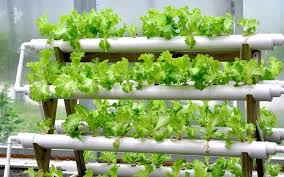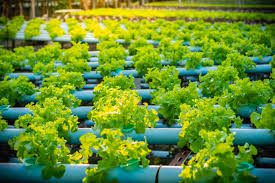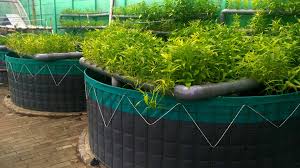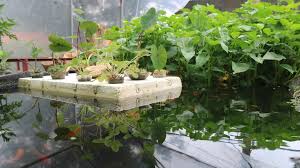Aquaponic gardening is an innovative and sustainable method of food production that combines aquaculture (raising fish) and hydroponics (growing plants without soil). This system creates a symbiotic environment where fish waste provides essential nutrients for plants, while plants help filter and purify the water for fish.
As the global population continues to rise and the demand for fresh, local food increases, aquaponics offers a viable solution to food security challenges. With its ability to produce a variety of fruits, vegetables, and fish in a compact space, aquaponic gardening has gained popularity among urban dwellers, hobbyists, and commercial growers alike.
Setting up an aquaponic system may seem complex, but it can be simplified with the right tips and techniques. Whether you are a beginner or an experienced gardener looking to diversify your methods, understanding the fundamental principles of aquaponics is essential for success. One of the main advantages of aquaponics is its efficiency.
The closed-loop system minimizes water usage, making it an excellent choice for regions with limited water resources. In fact, aquaponics uses up to 90% less water than traditional soil gardening, as water is continuously recirculated.
In an aquaponic system, fish serve as a natural fertilizer. When fish excrete waste, it breaks down into ammonia, which is then converted into nitrites and nitrates by beneficial bacteria. These nutrients are absorbed by plants, allowing them to grow without the need for chemical fertilizers.
This organic approach not only benefits the plants but also contributes to a healthier ecosystem overall. Additionally, the plants help maintain water quality by absorbing excess nutrients, ensuring a balanced environment for the fish.
When starting an aquaponic garden, choosing the right fish and plants is crucial. Popular fish options include tilapia, goldfish, and catfish, as they are hardy and adapt well to various water conditions. For plants, leafy greens such as lettuce, kale, and herbs are excellent choices, as they thrive in nutrient-rich water. It’s essential to consider the compatibility of fish and plants to create a harmonious ecosystem.
Maintaining the right balance of pH, temperature, and oxygen levels is also vital for the health of both fish and plants. Regular monitoring and adjustments will help ensure optimal growth conditions. Additionally, understanding the nitrogen cycle is fundamental for managing your aquaponic system effectively. This cycle includes the conversion of fish waste into usable nutrients for plants, and it can take some time to establish, so patience is key.
Aquaponic gardening tips can help you navigate the intricacies of this rewarding method. With proper planning and care, you can create a thriving aquaponic garden that provides fresh, home-grown food while conserving water and resources. This eco-friendly approach not only contributes to sustainable living but also allows you to connect with nature and enjoy the satisfaction of growing your own food.
Benefits of Aquaponic Gardening

1. Sustainable Food Production: Aquaponics combines aquaculture (raising fish) and hydroponics (growing plants in water) to create a self-sustaining ecosystem. This method significantly reduces the need for chemical fertilizers and pesticides, promoting organic food production.
2. Water Efficiency: Aquaponic systems use up to 90% less water than traditional farming methods. Water is recirculated within the system, minimizing waste and conserving this vital resource.
3. Space Saving: Aquaponics can be implemented in small spaces, making it ideal for urban environments. Vertical gardening techniques allow for maximizing space while growing a variety of plants.
4. Faster Plant Growth: The nutrient-rich water from the fish provides plants with essential nutrients, leading to faster growth rates and higher yields compared to conventional soil gardening.
5. Dual Harvest: Growers can enjoy a dual harvest of both fish and plants, increasing the overall productivity of the system. This provides a diverse source of food and income.
6. Educational Opportunities: Aquaponics serves as an excellent educational tool for teaching concepts of ecology, biology, and sustainable agriculture. It engages learners of all ages in hands-on experiences.
Essential Components of an Aquaponic System
1. Fish Tank: The heart of the aquaponic system, where fish are raised. The size of the tank depends on the number and species of fish being cultivated.
2. Grow Beds: These are where plants are grown. Grow beds are typically filled with a growing medium (like gravel or expanded clay) that supports the plants and helps filter the water.
3. Water Pump: A pump is necessary to circulate water from the fish tank to the grow beds. It ensures that plants receive nutrients while returning clean water back to the fish.
4. Aeration System: Air stones or diffusers help oxygenate the water, ensuring that fish and beneficial bacteria have sufficient oxygen to thrive.
5. Filtration System: While beneficial bacteria provide biological filtration, mechanical filtration can help remove solids from the water, maintaining clarity and quality.
6. Nutrient Cycling: The process by which fish waste is converted into nutrients for plants. Beneficial bacteria play a crucial role in this nitrogen cycle.
7. Monitoring Equipment: pH meters, ammonia testers, and thermometers help maintain optimal water quality and conditions for both fish and plants.
Choosing the Right Fish for Your Aquaponic
1. Tilapia: Highly recommended for beginners due to their hardiness and ability to thrive in various conditions. They grow quickly and can tolerate a wide range of water temperatures.
2. Catfish: Another great option, catfish are bottom feeders and can be grown in lower water quality conditions. They have a good growth rate and are popular in aquaponics.
3. Trout: Ideal for cooler climates, trout require well-oxygenated water and lower temperatures. They are more sensitive than tilapia or catfish but can be rewarding if managed correctly.
4. Goldfish: While not a food fish, goldfish are excellent for small systems and educational purposes. They can tolerate varying water conditions and help cycle the system.
5. Koi: Similar to goldfish, koi are primarily ornamental. They require good water quality and are kept for their beauty rather than for food production.
6. Native Fish: Research local regulations and suitable species that can be integrated into your system. Native fish can be more sustainable and easier to manage.
Read Also: 16 Medicinal Health Benefits Of Scleromitrion diffusum (Spreading Diamond Flower)
Selecting Suitable Plants for Aquaponics

1. Leafy Greens: Plants like lettuce, spinach, and kale are ideal for aquaponics due to their fast growth rates and low nutrient requirements. They thrive in the nutrient-rich water provided by fish waste.
2. Herbs: Basil, mint, and parsley are excellent choices. They grow well in aquaponic systems and can add significant value to your harvest.
3. Fruiting Vegetables: Tomatoes, peppers, and cucumbers can be grown in aquaponics but require more nutrients than leafy greens. Ensure your fish population is sufficient to provide these nutrients.
4. Root Vegetables: While more challenging, some aquaponic systems successfully grow root vegetables like carrots and radishes. They require deeper grow beds and more attention to water quality.
5. Flowers: Edible flowers, such as nasturtiums and marigolds, can also be integrated into aquaponics, enhancing biodiversity and attracting beneficial insects.
6. Perennial Plants: Consider incorporating perennial herbs and vegetables that will continue to be produced over several growing seasons, reducing the need for replanting.
Setting Up Your Aquaponic System
1. Choose Your System Type: Select an aquaponic system that fits your space and budget, such as media-based systems using gravel for plants, nutrient film technique (NFT) for thin film nutrient flow, or deep water culture (DWC) where plants float in nutrient-rich water.
2. Gather Essential Components: Ensure you have necessary components like a fish tank, grow beds, water pump, aeration system, filtration system, and tubing.
3. Set Up the Fish Tank: Choose an appropriate location, fill the tank with water, and ensure it meets the required levels for your chosen fish species.
4. Install the Grow Beds: Position the grow beds above or adjacent to the fish tank and fill them with suitable growing medium to support plant roots.
5. Connect the Water System: Install the water pump and connect tubing from the pump to the grow beds, allowing proper drainage back to the fish tank.
6. Cycle Your System: Before adding fish, cycle your system for 4-6 weeks to establish beneficial bacteria that convert fish waste into nutrients.
Maintaining Water Quality in Aquaponics
1. Monitor pH Levels: Aim for a pH range of 6.5 to 7.5, which is ideal for both fish and plants; use pH test kits to check levels regularly.
2. Test Ammonia, Nitrite, and Nitrate Levels: Keep ammonia below 0.5 ppm, nitrite at 0 ppm, and nitrate ideally between 20-40 ppm for optimal plant growth.
3. Maintain Dissolved Oxygen Levels: Ensure dissolved oxygen levels are above 5 mg/L for fish health, using aerators or air stones to enhance oxygenation.
4. Regular Water Changes: Perform partial water changes (10-20%) every few weeks to remove excess nutrients and maintain overall water quality.
5. Control Temperature: Keep water temperatures appropriate for your fish species (usually between 70°F and 80°F) using heaters or coolers as necessary.
Read Also: 12 Medicinal Health Benefits Of Renealmia alpinia (Pink cone ginger)
Nutrient Management in Aquaponic Gardens

1. Understand Nutrient Requirements: Identify the nutrient needs of the plants, including nitrogen, phosphorus, potassium, calcium, magnesium, and trace elements.
2. Monitor Nutrient Levels: Test nutrient concentrations regularly using water testing kits to ensure plants receive adequate nutrition.
3. Supplement Nutrients as Needed: If deficiencies arise, consider natural supplements like fish emulsion for nitrogen and seaweed extract for trace minerals.
4. Observe Plant Health: Monitor for signs of nutrient deficiency such as yellowing leaves and stunted growth, and adjust nutrient management strategies accordingly.
Pest and Disease Control in Aquaponics
1. Integrated Pest Management (IPM): Implement strategies like cultural controls (crop rotation) and biological controls (introducing beneficial insects).
2. Monitor for Signs of Pests and Diseases: Regularly inspect plants for pests like aphids or spider mites and for fungal infections for early detection.
3. Use Organic Pest Control Methods: Utilize neem oil, insecticidal soap, or diatomaceous earth to manage pest populations without harming fish.
4. Maintain Plant Health: Healthy plants are less susceptible to diseases; ensure proper watering, nutrient levels, and environmental conditions.
Harvesting and Using Aquaponic Produce
1. Harvesting Fish: Determine the appropriate harvest time based on species and market size, using a net to catch fish gently.
2. Harvesting Plants: Cut leafy greens at the base for regrowth, and wait until fruits reach maturity before harvesting.
3. Proper Storage: Store harvested fish in a cool environment and use promptly; keep greens in the refrigerator with high humidity to extend shelf life.
4. Utilizing Aquaponic Produce: Experiment with recipes using fresh fish and vegetables from your system and promote the health benefits of homegrown produce.
Do you have any questions, suggestions, or contributions? If so, please feel free to use the comment box below to share your thoughts. We also encourage you to kindly share this information with others who might benefit from it. Since we can’t reach everyone at once, we truly appreciate your help in spreading the word. Thank you so much for your support and for sharing!
Read Also: Complete Composting Guide for Beginners






